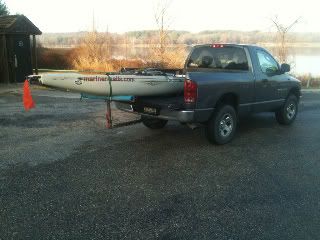I’ve actually experimented with both the homemade PVC rack approach and the store-bought bed extender, so I can give you some perspective on the pros and cons.
Your idea of using a 2x4 frame with PVC bunks works surprisingly well for sliding a PA on and off with minimal effort. The PVC acts like rollers, and combined with the wheel wells as stops, it keeps things fairly secure. However, I’d recommend adding some sort of padding (rubber matting or carpet strips) where the hull makes contact—PVC can be slippery, but over time it may leave marks or wear on certain spots if the kayak shifts during transport.
One thing to consider: wind resistance and overhang. With your 6’6” bed and tailgate down, you’ll have decent support for most of the PA’s length, but the stern will still extend beyond the tailgate. Make sure your strapping points are solid and that you add a red flag to comply with road regulations.
The bed extender is another solid option—less fabrication time, adjustable height, and easy to remove when not in use. Many paddlers (myself included) use a hybrid approach: a basic PVC bunk inside the bed for smooth loading, paired with a bed extender for extra support. That setup minimizes stress on the hull and spreads the weight more evenly.
If you’re leaning toward the DIY route, I’d suggest making it modular so you can pull it out quickly when you need the bed for other uses. Use exterior-grade screws and water-resistant wood sealant to keep the frame from degrading over time.
Either way, a well-secured PA rides just fine in a pickup—just plan for those occasional long hauls where extra support is worth the investment.
tente de toit 4x4 |
tente de toit pour pick up |
tente de toit voiture |
tentes de toit James Baroud










